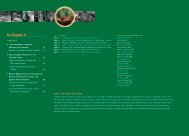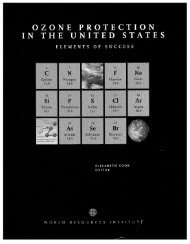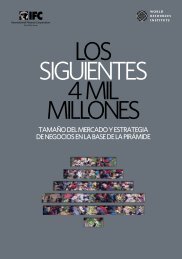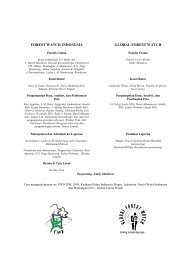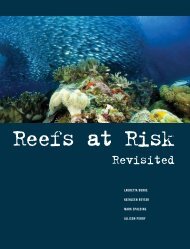GLObAL COAL RISK ASSESSmENT - World Resources Institute
GLObAL COAL RISK ASSESSmENT - World Resources Institute
GLObAL COAL RISK ASSESSmENT - World Resources Institute
You also want an ePaper? Increase the reach of your titles
YUMPU automatically turns print PDFs into web optimized ePapers that Google loves.
Data Gap for Global Coal Trade<br />
Further research is required to identify the major<br />
companies/investors in infrastructure developments<br />
for coal trade expansion.<br />
The proposed capacity of new infrastructure development<br />
is significantly bigger than projected demands.<br />
Further study should analyze the possibilities and<br />
consequences of over-construction.<br />
Further research is needed to understand how growing<br />
coal imports will affect domestic coal markets and coal<br />
power developments in countries such as China and India.<br />
Further research is required to analyze how the reductions<br />
in nuclear power in Japan and Taiwan will affect<br />
their coal imports. Both countries depend entirely on<br />
coal imports for their huge coal power generations.<br />
Further research is required to identify the source of<br />
coal supply for the proposed new coal-fired plants in<br />
countries with no domestic coal production capacities.<br />
These include Cambodia, Dominican Republic, Guatemala,<br />
Laos, Morocco, Namibia, Oman, Senegal, Sri<br />
Lanka, and Uzbekistan.<br />
Data Gap for Coal Finance<br />
Global Coal Risk Assessment<br />
Most of the literature reviewed for this paper was produced<br />
by NGOs, including Coalswarm, the Environmental<br />
Defense Fund, and the Sierra Club. It would be<br />
useful to review industry materials, in order to better<br />
understand how the industry views the risks of financing<br />
coal development. An understanding of how risks<br />
associated with coal finance are assessed by the industry<br />
would be especially useful for climate advocates.<br />
More in-depth research is required to unpack how<br />
financing for coal projects works: the elements of a<br />
financing package, how public and private banks interact,<br />
and what role government plays. A solid understanding<br />
of how deals are made is crucial to developing<br />
an effective work strategy.<br />
This paper briefly touches on different forms of subsidies<br />
for coal projects. More country-based research<br />
is needed to understand how coal is subsidized in a<br />
particular country. Further research should also attempt<br />
to quantify the size of subsidies. This work could<br />
be linked to the ongoing global “phase out fossil fuel<br />
subsidies” discussions.<br />
There is little existing research that examines how<br />
coal finance works in India and China—the two fastest<br />
growing markets dominated by domestic players. It is<br />
not clear to what extent coal-fired plant projects rely<br />
on bank financing in these countries. Banks in China<br />
and India do not appear vulnerable to the same reputational<br />
risks as their international peers. A closer look<br />
at the coal financing models in India and China could<br />
perhaps shed light on how effective finance campaigning<br />
can be organized in these two countries.<br />
WORKING PAPER | November 2012 | 23




